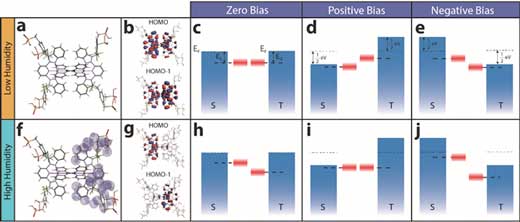| Posted: Dec 04, 2017 |
Humidity switches molecular diode off and on
(Nanowerk News) In 2016, Ben Feringa received the Nobel Prize—with Stoddard and Sauvage— for developing molecular motors. His work provides a spectacular example of a broader research area where scientists study molecules with a chemically programmed function. Apart from motors, they also work on molecular diodes, switches and transistors, all with a typical length of a nanometer. These represent the ultimate miniaturization: if you make them even smaller, you’d have to break the molecule and are left with separate atoms.
|
|
Leiden physicists Sense Jan van der Molen and Huseyin Atesci, together with Delft, Bern and Chuo (Japan), have now developed and demonstrated the first switchable molecular diode (Nature Nanotechnology, "Humidity-controlled rectification of ruthenium-complex molecular junctions").
|
 |
| Top: Low humidity. At zero voltage (c), the energy levels of the left and right side of the symmetrical molecule (a) are equal. Now if we apply a voltage, the energy levels will shift with respect to each other. The distance between the levels is independent of positive (d) or negative (e) voltage. Therefore, an equally large current will flow for positive and negative voltage.
Bottom: High humidity. Because the water resides on one side of the molecule, the symmetry between the energy levels breaks already at zero voltage (h). At positive voltage (i), the energy levels get closer together, so a significant current can flow. However, a negative voltage (j) enlarges the difference between both levels, so the current is blocked. (click on image to enlarge)
|
Humidity
|
|
The scientists discovered that the electric conductivity of the molecule ‘2-Ru-N’ depends on humidity. In dry circumstances, the same amount of current flows through the molecule under positive or negative voltage. This changes dramatically in a humid environment. In that case, only a positive voltage induces a current. With this, the researchers have created a molecular circuit that works as a unique combination of a switch and a diode: a switchable molecular diode that you can turn on and off with humidity. Vice versa we can see the molecule as a humidity sensor based on the structure of a specific molecule.
|
Asymmetry
|
|
The tiny diode works by means of an asymmetry caused by water molecules. At around 60% humidity they lump together at the right side of the molecular layer (see figure, f). This causes an imbalance between the energy levels on both sides (h), which strongly limits the flow of electrons. A positive voltage across the molecule lifts the energy level of the right side (i), so the levels’ alignment is restored and current flows again. A negative voltage on the other hand creates an even larger asymmetry (j) and even less current. Under dry circumstances, the molecule’s symmetry doesn’t break and the diode behavior disappears.
|
Principle
|
|
‘The whole principle is based on symmetry, so it doesn’t exclusively apply to water,’ says Van der Molen. ‘In theory our principle also works with for example alcohol or toxic gases.’ This means the discovery does not just relate to measuring moisture in the air. If scientists find a suitable molecule in the future consisting of two symmetric halves, just as ‘2-Ru-N’, the principle enables other sensors too, like a molecular alcohol test or carbon monoxide detector.
|

